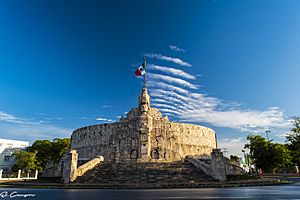Paseo de Montejo facts for kids
Paseo de Montejo is a famous street in Mérida, México. It's named after Francisco de Montejo, a Spanish explorer who founded the city in 1542. This avenue is home to many important buildings and statues.
The design of Paseo de Montejo was inspired by French boulevards. These are wide streets often lined with trees. You'll find many trees and roundabouts along the avenue. In the 1800s, rich families from Yucatán built beautiful mansions here.
Paseo de Montejo starts north of the city center, near the Santa Ana neighborhood. It stretches for over 6 kilometers (about 3.7 miles). This makes it one of the longest streets in Mérida. It even connects to Highway 231, close to the Gran Museo Maya (Mayan Museum).
How Paseo de Montejo Began
In the late 1800s, Yucatán became very rich. This was thanks to the henequen plant, which was called "green gold." Henequen was used to make ropes and other products. Because of this wealth, many fancy buildings were built, especially homes.
At that time, Mérida did not have any wide avenues. The main gathering spots were places like La Alameda and El Camposanto.
The Idea for a Grand Avenue
From 1886 to 1889, Guillermo Palomino was the governor. He had an idea to make Mérida more modern. He wanted to expand the city's developed areas. This was a perfect time because the economy was doing very well.
In January 1888, this idea became a plan. With help from local farmers, business owners, and traders, they decided to build a grand street. They named it "Paseo de Montejo." Their goal was to make the city more modern. They also wanted to create a new place for people to meet and for businesses to thrive.
See also
 In Spanish: Paseo de Montejo para niños
In Spanish: Paseo de Montejo para niños


